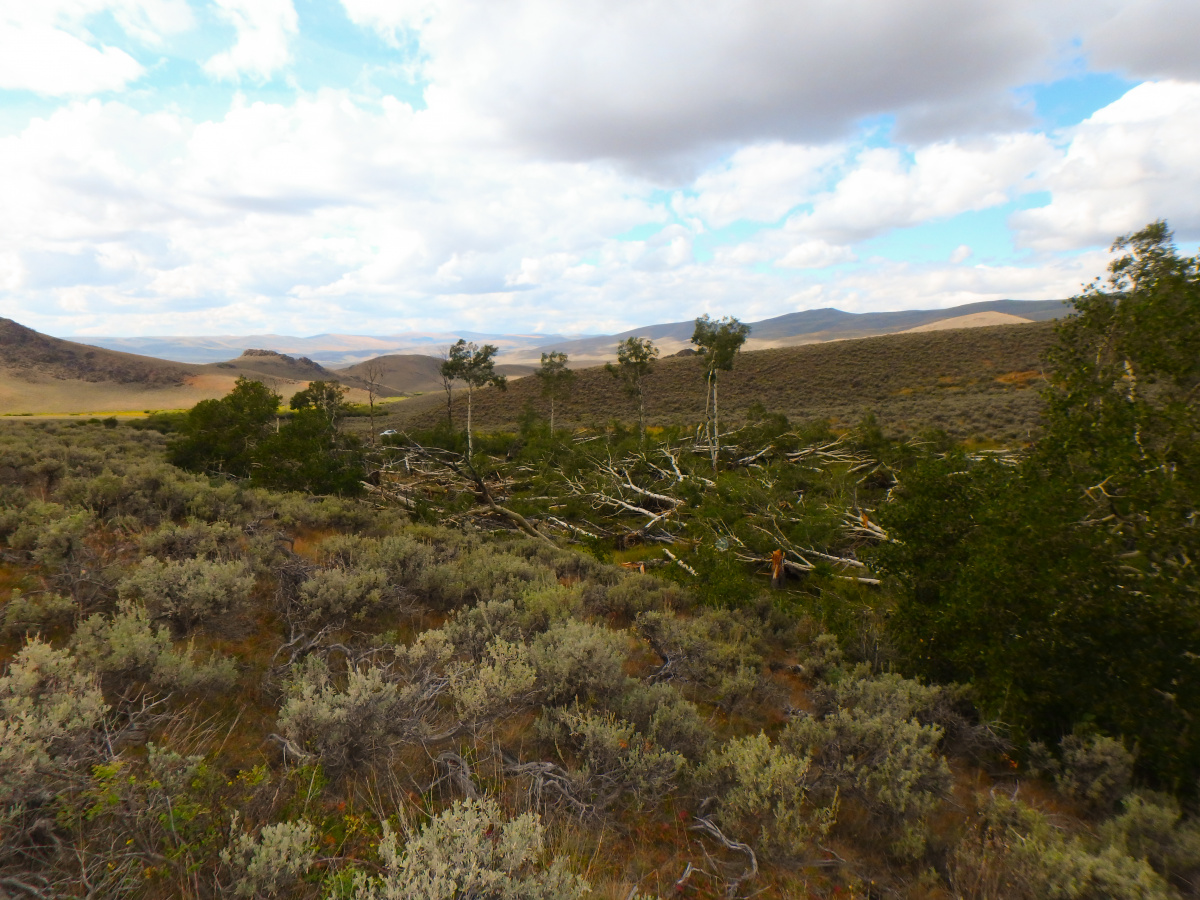You are viewing ARCHIVED content published online before January 20, 2025. Please note that this content is NOT UPDATED, and links may not work. Additionally, any previously issued diversity, equity, inclusion or gender-related guidance on this webpage should be considered rescinded. For current information, visit https://www.blm.gov/blog.
Dillon Field Office and local partners undertake unique aspen-restoration project
Story and Photos by Kipper Blotkamp, Dillon Field Office Forester
The Dillon Field Office’s Sage Creek watershed is big, wide-open country, even by southwest Montana standards, and the vast majority of the area is blanketed with vegetation no taller than a fence post. Hidden among the sagebrush, in the folds and creases of the landscape, there’s more diversity than meets the eye.
Sedge-lined, spring-fed streams meander through the namesake sagebrush sea, and some of these lifelines of water support willow and aspen communities. Riparian corridors with woody deciduous vegetation offer shade, food and water all in the same place, creating ribbons of paradise for people, wildlife and permitted livestock alike. Unfortunately, many of these cool, moist strips of riparian greenery are slowly but surely disappearing from the landscape.
In 2015, as part of their land health assessment process, a Dillon Field Office interdisciplinary team of resource specialists assessed each mile of flowing water on BLM-administered land in the Sage Creek watershed. The team found miles of dead aspen “skeletons” rotting along the banks of many streams, and almost no aspen regeneration growing taller than knee-height due to repeated, intense ungulate browsing. The few remaining live aspen trees were past their life expectancy, and were valiantly attempting to regenerate by suckering.
This is the issue the DFO identified on the ground, and is actively trying to resolve: How can the BLM help protect young aspen from being consumed by ungulates so individual shoots can grow tall enough to escape hungry mouths? As land managers, what can we do to keep the life of the aspens from completing blinking out from this landscape?
Fence exclosures are commonly used to restrict livestock and wildlife from browsing woody riparian vegetation, which ideally allows a new generation of deciduous trees or shrubs to grow taller than browse height. While fences might help the aspen regenerate successfully, they’re also expensive and require maintenance to remain effective. And fences can have unintentional, detrimental consequences to wildlife.
As an alternative, Dillon Field Office forester Kipper Blotkamp proposed a different tactic: use the over-mature, dead and dying aspen, and the old skeletons already on the ground, to create a temporary browse barrier to physically protect the future generation of aspen from hungry mouths.
A treatment design was complete and now it was time to execute. However, federal budget cycles and internal deadlines don’t often line up with accomplishing a multitude of on-the-ground objectives. Fortunately, a locally-led partnership is focused on ratcheting up restoration work in the sagebrush steppe of the field office.
The Southwest Montana Sagebrush Partnership (specifically the Beaverhead Watershed Committee) expressed an interesting in helping with the BLM’s aspen protection proposal. Taking advantage of a watershed restoration agreement between the BLM and the Watershed Committee, the BLM was able to obligate funds for the project when they were available, then hire a skilled local contractor to complete the project when conditions were optimal, not when it was just a convenient point in time of the federal fiscal year.

In September 2019, a 42,000-pound excavator creaked its way into the last remnants of a dying aspen clone struggling for life along the banks of Heifer Creek. The BLM’s directive was to “make a strategic mess.”
“I asked Rick Smith, owner of Blacktail Services and an extremely talented heavy equipment operator, to make it as difficult as possible for elk, moose and cattle to access the struggling aspen suckers” Blotkamp said. “Smith thought about the unusual request for a few minutes, asked a few questions, and then said he could make it happen.”
A tracked excavator with a thumb was the equipment of choice because of its low ground pressure, and its ability to reach out, pick up, and strategically place individual pieces of woody material to protect young aspen suckers. Smith was able to directionally push over the slowly-dying aspen trees with the excavator bucket. He then strategically placed the pieces in a crisscross pattern to deter ungulate browse. Aspen skeletons already on the ground were added to the “mess,” further strengthening the temporary browse barrier.
Hopefully, given enough time without repeated browsing and access to full sunlight, the vigorous, young aspen will respond by growing up to several feet per year, finally grow taller than ungulates can reach. That’ll be the new aspen stand which will offer sought-after and valuable habitat along the banks of Heifer Creek for decades to come.
Related Stories
- Monument map earns ‘finalist’ honors in global GIS awards
- BLM Fire and National Conservation Lands managers collaborate to meet shared goals
- Recreation for all: Accessibility on Montana-Dakotas public lands
- North Central Montana District employees celebrate new adoption
- BLM Billings Field Office works with state agencies in Montana to conduct bat surveys
